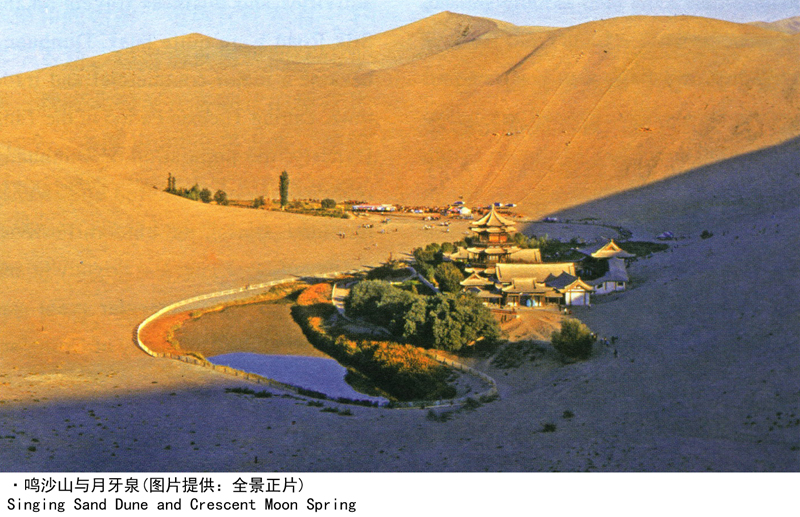丝路概说
- 交通路线
- 长安与丝绸之路
- 从长安到罗马——汉唐丝路全程探行纪实上
- 从长安到罗马——汉唐丝路全程探行纪实下
- 海上丝路史话
- 丝绸之路史研究
- 早期丝绸之路探微
- 早期丝绸之路文献研究
- 中西丝路文化史
- 沧桑大美丝绸之路
- 传播友谊的丝绸之路
- 路途漫漫丝貂情——明清东北亚丝绸之路研究
- 世界的中国——丝绸之路
- 丝绸之路
- 丝绸之路寻找失落的世界遗产
- 丝绸之路2000年
- 丝绸之路——从西安至帕米尔
- 丝绸之路经济带发展报告2014
- 丝绸之路考古十五讲
- 丝绸之路——神秘古国
- 丝绸之路——沿线城镇的兴衰
- 丝绸之路在中国
- 丝路景观
- 丝路起点长安
- 丝路文化新聚焦
- 丝路之光——创新思维与科技创新实践
- 中国丝绸之路交通史
- 中华文明史话-敦煌史话
- 中国·北海合浦海上丝绸之路始发港理论研讨会论文集
- 丝绸之路
- 丝绸之路新史
- 西域考古文存
- 丝绸之路的起源
▲敦煌
作者:方明




敦煌是古丝绸之路上的著名驿镇,位于河西走廊的西端,也是甘肃省最西部的城市。此地在春秋时期以前称“三危”,至春秋时,也许由于境内盛产美瓜,改称“瓜州”。敦煌之名始于汉代,“敦”是“大”的意思,而“煌”是“盛”的意思。自汉武帝元鼎六年(前111)设置敦煌郡后,人们就习惯以敦煌为界,将其以西称为“西域”。唐武德二年(619),设置沙州,因城南有鸣沙山而得名。翻开丝绸之路的路线图,进入新疆的3条路线都以敦煌为出发点。无论东来还是西去的商旅,必须经过敦煌,所以史书上有去西域诸道“总辏于敦煌”的记载。自汉迄唐,丝路上商旅往来频繁,敦煌成为商贸重镇,佛塔遍地,市场繁荣。唐天宝年间,敦煌人口达到近12万,元宵灯节时城中灯火通明,盛况仅次于长安,其兴旺程度可见一斑。
令敦煌闻名于世的还是被称为“艺术宝库”的佛教石窟。敦煌境内的石窟包括莫高窟(又称“千佛洞”)、榆林窟(又称“万佛峡”)和西千佛洞三处,其中以莫高窟规模最大、内容最为丰富。莫高窟位于敦煌东南25公里处,凿于鸣沙山东麓的崖壁上,全长约1600米。据唐代碑文记载,莫高窟最初开凿于前秦建元二年(366),由乐僔和尚始凿,至唐代已经有一千多个石窟。经过后世历代的陆续开凿,现存北魏至元各朝代的洞窟共492个,壁画45000多平方米,彩塑像3000余身。石窟中还先后发现近6万件4—14世纪的珍贵文物,包括各种写经、文书、帛画等,是研究中国古代政治、经济、军事、文化、艺术、宗教,以及中外交通、文化交流的重要历史资料。1987年,联合国教科文组织把莫高窟列为世界文化遗产,并评价:“莫高窟地处丝绸之路的一个战略要点。它不仅是东西方贸易的中转站,同时也是宗教、文化和知识的交汇处。莫高窟的492个小石窟和洞穴庙宇,以其雕像和壁画闻名于世,展示了延续千年的佛教艺术。”
>Dunhuang
Sitting on the west end of the Hexi Corridor,Dunhuang used to be a famous posthouse town on the ancient Silk Road and the west-most city of Gansu Province.Dunhuang area was known as〝San Wei"prior to the Spring and Autumn Period and changed to〝Guazhou"(land of melons)due to its abundant melon products.The current name Dunhuang was adopted in the Han Dynasty,meaning〝large and prosperous".Since its official incorporation as a County in 111 B.C.(6th year of the Yuanding Period during Emperor Wu of the Han Dynasty),Dunhuang has been habitually regarded as the border.West of Dunhuang was referred to as the Western Regions.In 619(2nd year of the Wude Period of the Tang Dynasty),Dunhuang was renamed Shazhou(Sand Kingdom),following the Singing Sand Dunes in the south of the city.The three routes of the ancient Silk Road leading to Xinjiang all refer to Dunhuang as the starting point.As all business travellers going either east or west have to go through Dunhuang,it was recoded in history books that all roads to the west converge at Dunhuang.From the Han to the Tang Dynasty,commercial activities and business travels on the Silk Road were quite busy.Dunhuang became a major commercial and trade town.During Tianbao Period of the Tang Dynasty,the population of Dunhuang increased to one hundred and twenty thousand.During the Lantern Festival,the city of Dunhuang was brightly lit and the scale of the spectacular event was only next to the capital city of Chang'an,a full indication of its prosperity.
Dunhuang is also well-known for its Buddhism Grottoes.There are three major grotto sites in Dunhuang,i.e.Mogao Grottoes(Thousand Buddha Caves),Yulin Grottoes(Ten Thousand Buddha Valley)and West Thousand Buddha Caves.Located twenty-five kilometers southeast of the city,the Mogao Grottoes site is the largest of the three.Built on the cliff of the east foothill of the Mingsha Mountain,the total length of the grotto site is about 1.6 kilometers.According to records on the Tang Dynasty tablet,construction of the Mogao Grottoes first started in 366(2nd year of the Jianyuan Period during Former Qin)by a monk named Lezun.By Tang Dynasty,there were over a thousand grottoes built on the mountain cliff.With successive generations'efforts,the number of existing grottoes built since the Northern Wei till the Yuan Dynasty amounts to four hundred and ninety-two,entailing over forty-five thousand square meters mural paintings and more than three thousand color sculptures.Nearly sixty thousand pieces of precious cultural relics between the 4th and the 14th centuries have been found from the grottoes by far.In 1987,Mogao Grotto site was listed as a world heritage by UNESCO with the following statement:Mogao Grottoes are located on a strategic point of the Silk Road.Dunhuang was not only the transit hub for east-west trade,but also the merging point for religion,culture and knowledge.The four hundred and ninety-two caves are known to the world for the sculptures and mural paintings they contain,demonstrating the Buddhist art that has lasted for over a thousand years.
敦煌的飞天
敦煌莫高窟的众多石窟中都绘有大量的飞天形象。飞天,是佛教中的天神乾达婆和紧那罗的化身,他们的职责是为佛奏乐歌舞、散发香气、献花供宝。敦煌飞天的形象是在中国传统神仙传说的基础上,吸收融合外来佛教艺术的特点发展而来的,最大的特征是借助云彩衬托,凭借飘曳的衣裙和彩带凌空翱翔,千姿百态,美不胜收。
莫高窟中现在能看到最早的飞天形象绘于北凉时期(401—439)。这些飞天头戴宝冠,上身半裸,身体弯曲,但略显僵硬。到了西魏时期(535—556),飞天形象变为上身裸露,肩膀披着彩带,脖子佩戴项链,下身穿长裙。其形象开始符合当时中国人的审美特点,体态瘦削,眉清目秀,纤长的手中拿着各种乐器演奏,再加上周围饰有祥云花瓣,场面祥和。隋代(581—618)时,飞天的形象更加优美,装饰也更加多样化。唐代(618—907)的飞天昂首挺胸,两只脚向上翘起,裙子和丝带随风舞动,微笑着向天空中散花,轻盈而又富有朝气,不仅体现了佛教氛围,而且还融入了盛唐时期人们自信乐观的精神状态。
Flying Apsaras in Dunhuang Grottoes
In many Mogao caves,there are images of flying Apsaras who are believed to be incarnations of heavenly gods Gandharvas and Kinnara in Buddhism.Their role and responsibility include:playing music and dance for Buddha,emitting fragrance,and offering precious flowers.Based on traditional Chinese legends about immortals,the flying Apsaras images were developed by integrating some features of exotic Buddhist art,the most prominent being the employment of clouds.With floating dresses and ribbons,the Apsaras soar up in the sky in all kinds of postures,vary beautiful and graceful.
The earliest existing flying Apsaras images at Mogao Grottoes were painted during the Northern Liang Period(401-439).With a crown on the head and half-naked upper body,these Apsaras present a slightly stiff bending posture.By Western Wei Period(535-556),the image of flying Apsaras changed into one of a topless beauty,with ribbons draping from the shoulders and a long skirt.The image also wears a necklace.The image began to comply with the then Chinese people's aesthetic preferences:a slender body,delicate features,holding a variety of musical instruments in their slim fingers.The surrounding petals and auspicious clouds present a peaceful scene.Images of the Flying Apsaras became more beautiful and decorative during the Sui Dynasty(581-618).Flying Apsara images depicted during the Tang Dynasty(618-907)are featured by a raised head,upward tilted feet,and dancing skirts and ribbons.With a smiling face,the Apsaras scatter flowers in the sky.They are so light and agile,full of vigor and vitality.They not only embody the Buddhism atmosphere,but also mirror the confidence and optimism of people during the Flourishing Tang Period.
丝绸之路/方明编著.-合肥: 黄山书社, 2013;